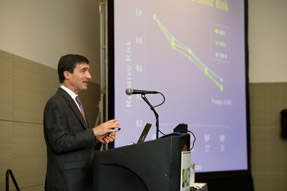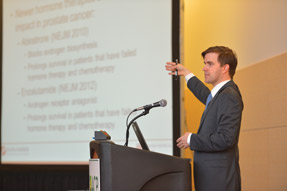Workflow adjustments can yield small practice satisfaction
Physicians considering joining an accountable care organization should take an active role from the beginning stages, first by developing benchmarks for effective practice, and then building strong relationships with subspecialists.
Internists starting or considering joining an accountable care organization (ACO) should make sure they have a seat at the table, advised Edward A. Stehlik, MD, MACP. “It's important that the people who lead the organization ... are invested right from the beginning in supporting primary care,” he said.
Dr. Stehlik, whose 2-physician practice in Tonawanda, N.Y., is part of an ACO and high-performing health system, spoke about small practice survival at a session on “The Evolution of New Payment Models: How to Prepare and Prosper as a Small Practice” at Internal Medicine Meeting 2015.
Other things to consider when working with an ACO are financial support from the organization, administrative support and services, and the availability of measurable data. “As you're trying to look at outcomes and look at how successful you are individually, you have to make sure that the organization is providing actionable data that's accurate,” Dr. Stehlik said. “You need to be engaged with your organization to make sure that these are their priorities, or you shouldn't be there.”
Primary care physicians practicing in ACOs should also take care to develop effective and more interactive subspecialty relationships, Dr. Stehlik said. He recommended having specific written agreements defining how to communicate before a consultation and how to exchange information afterward. Group meetings with selected high-profile subspecialties can be particularly useful in breaking the silos in which different subspecialties can sometimes practice.
“It doesn't take long for different specialty groups to realize that we as primary cares are interested in how they practice, helping them to model their practices, the way they spend money, the way they order tests, and the way they do things in concert with our preferences,” Dr. Stehlik said. He also noted that it's important to develop efficiency measures to analyze how subspecialists care for patients. “We want to know that someone does a better job than others in measurable ways,” he said.
At the practice level, optimal referral management in ACOs can mean a 1-on-1 conversation. For example, Dr. Stehlik noted that his city has 2 large hospital systems and many subspecialists practice in both. “If 1 of your patients has ... elective surgery in the other system, which is financially very disruptive for the organization, a phone call from me to the specialist frequently changes how that [referral] takes place in the future and improves your financial efficiency,” he said.
In addition, in a practice that uses hospitalists, a robust care transition program is a must, Dr. Stehlik stressed. “Having a very aggressive care transition program involving both the emergency room and the hospitalist, to make sure that your patients aren't admitted unnecessarily and that you see them back again quickly so that you avoid future hospitalizations, is a key,” he said.
Dr. Stehlik also discussed ways to transform your practice to adjust to the changing health care environment. He pointed out that physicians are burdened with change from alternative payment models, electronic medical records, consumerism, pay for performance, ICD-10, and quality measures.
“For those of you who've practiced before electronic medical records through the transition up until now, what you've seen ... is that the workload per patient and per visit has really increased very dramatically,” he said. “We're burdened with a lot of administrative and clerical work. We see that and we know it, but because there's really been no light at the end of the tunnel, we're still doing things more or less the old way. But the old ways really don't work very well since we've changed over.”
Dr. Stehlik offered 2 methods of alleviating these pressures that he and his practice have found helpful and said that the first, facilitated documentation, has been transformational. “I mean that in my heart and soul,” he said. “I have been practicing for 34 years, and in the last 6 months, I've never been happier or enjoyed my practice more than starting to use scribing in my practice.”
Using scribes encourages team-based care and can help a practice make more money, Dr. Stehlik said, but “more important than that is the fact that it takes a lot of the drudgery, the administrative work, the paperwork, the clutter, off of your shoulders and gives it to someone else.”
Clinicians who don't use a scribe, he said, have probably made negative changes to the way they practice, such as seeing fewer patients per hour than they could have done or did before and working longer hours. In addition, he said, “texting while doctoring” has become commonplace.
“Many of you probably think you don't do it. If you're using the computer in the room, you probably all are, and of course that's not the way we were trained and taught to take care of patients. We were taught to look at them,” he said.
Another way physicians can compromise, he said, is by copying and cutting and pasting in the medical record, resulting in notes that are “a bunch of gibberish” and don't provide a unique picture of the patient's condition.
Dr. Stehlik highlighted 3 hallmarks of good care: being attentive to and mindful of the patient; having a substantive, high-quality progress note that supports medical necessity; and being efficient.
“I will give you 1 caveat that I can support by no evidence except for the fact that it's true ... I do not believe it is possible—it's just not possible—to practice medicine well right now in primary care using electronic medical records and achieve all 3 of these standards without using a scribe,” he said.
The second technique Dr. Stehlik recommended is performing a 4-step “top of license” exercise in your practice.
In step 1, he said, identify all of the office's tasks and functions. In step 2, create columns for every job description, putting the physician's into the far right column. In step 3, he said, put each task in the “right” column, the one farthest to the left where it can be done. In step 4, redesign workflows and staffing based on what you determined in steps 1 through 3.
The 2 things in the office that only the physician can do, Dr. Stehlik said, are complex decision making and relationship building. “If you only spent your time during the day doing those things and had scribes and nurses doing everything else, you'd be much more efficient, productive, and get a lot of things done,” he said.
Dr. Stehlik recommended involving all staff in this exercise, including nurses, medical assistants, clerical staff, and managers. “The stuff that's on your plate that doesn't belong there, your passion should be to get rid of it and have someone else doing it, but you can't do that in a fiat, a dictatorial manner, in my experience. Get your staff engaged as well,” he said.
Dr. Stehlik noted that the question everyone asks after this exercise is “Can I afford higher staffing ratios to practice at the top of my license?” In answer, he gave the hypothetical example of a solo physician practice where the physician worked a 60-hour work week and netted $180,000 dollars per year. A top-of-license analysis found that 30% of the practice's activities were activities only the physician could do, 40% were activities the nurse practitioner could do as well, 20% were activities the RN/LPN could do as well, and 10% were activities the secretary could do as well.
If you took over this practice and maintained the status quo, you would hire a physician and pay him or her $85/hour or $265,000 per year, for a net loss of $85,000, and would have no growth capacity, Dr. Stehlik said. However, if you hired a team where all members are practicing at the top of their licenses, you would be paying:
- an MD or a DO $85/hour times 18 hours weekly, or $79,560;
- an NP $40/hour times 24 hours weekly, or $49,920;
- an RN $20/hour times 12 hours weekly, or $13,728;
- and a secretary $14/hour times 6 hours weekly, or $4,680.
The cost would be $147,888, saving $112,000, for a net profit of $32,112, Dr. Stehlik noted. Another bonus would be a marked increase in capacity, he said, because the physician would now be working 18 hours per week instead of 60.
“That's a model of why practice transformation using the top of the license isn't expensive,” he said. “It makes you money.”





